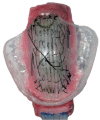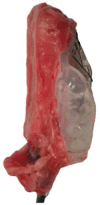Custom-designed mouthpiece for HDR brachytherapy of embryonal rhabdomyosarcoma of the soft palate
- PMID: 25337134
- PMCID: PMC4200176
- DOI: 10.5114/jcb.2014.44977
Custom-designed mouthpiece for HDR brachytherapy of embryonal rhabdomyosarcoma of the soft palate
Abstract
This paper describes the design and fabrication of the mouthpiece used for high-dose-rate (HDR) brachytherapy of a cancerous lesion in the soft palate of a pediatric patient. A custom mouth guard made with Thermo-forming material (Clear - Mouthguard) similar to those used by athletes, with a bite section, alveolar sulcus, hard and soft palate sections was made. Markers were placed around the lesion using a color transfer applicator and the impression transferred to the mouthpiece. Ten catheters arranged in a plane were placed on the inferior side (concave part) of the mouthpiece, and held in place by stitching each to the mouthpiece. Two pieces of lead (Pb) sheets with total thickness of 5.7 mm were placed beneath the catheters. Wax was used to create additional distance between the tongue and the catheters, and the entire assembly was covered with wax.
Keywords: HDR brachytherapy; mouthpiece; rhabdomyosarcoma; soft palate.
Figures






Similar articles
-
Simultaneous catheter and multicriteria optimization for HDR cervical cancer brachytherapy with a complex intracavity/interstitial applicator.Med Phys. 2024 Mar;51(3):2128-2143. doi: 10.1002/mp.16874. Epub 2023 Dec 3. Med Phys. 2024. PMID: 38043067
-
Technical hints for high dose rate interstitial tongue brachytherapy.Clin Oncol (R Coll Radiol). 1998;10(4):231-6. doi: 10.1016/s0936-6555(98)80006-x. Clin Oncol (R Coll Radiol). 1998. PMID: 9764374
-
Treatment of Stage I Hard Palate Cancer with High-Dose-Rate Brachytherapy Using Molds: Cost-Based Perspective.J Pharm Bioallied Sci. 2019 Feb;11(Suppl 1):S67-S71. doi: 10.4103/jpbs.JPBS_193_18. J Pharm Bioallied Sci. 2019. PMID: 30923433 Free PMC article.
-
Fabrication of a custom brachytherapy appliance.J Prosthet Dent. 2019 Mar;121(3):535-537. doi: 10.1016/j.prosdent.2018.07.002. Epub 2018 Dec 13. J Prosthet Dent. 2019. PMID: 30554822 Review.
-
A review of dosimetric impact of implementation of model-based dose calculation algorithms (MBDCAs) for HDR brachytherapy.Phys Eng Sci Med. 2021 Sep;44(3):871-886. doi: 10.1007/s13246-021-01029-8. Epub 2021 Jun 17. Phys Eng Sci Med. 2021. PMID: 34142317 Review.
Cited by
-
High-dose-rate brachytherapy of rhabdomyosarcoma limited to the external auditory canal.Brachytherapy. 2017 Jan-Feb;16(1):181-185. doi: 10.1016/j.brachy.2016.07.003. Epub 2016 Aug 12. Brachytherapy. 2017. PMID: 27528589 Free PMC article.
References
-
- Raney RB, Asmar L, Vassilopoulou-Sellin R, et al. Late complications of therapy in 213 children with localized, non-orbital soft-tissue sarcoma of the head and neck: a descriptive report from the Intergroup Rhabdomyosarcoma Studies (IRS)-II and -III. Med Pediatr Oncol. 1999;33:362–371. - PubMed
-
- Münter MW, Karger CP, Hoffner SG, et al. Evaluation of salivary gland function after treatment of head-and-neck tumors with intensity-modulated radiotherapy by quantitative pertechnetate scintigraphy. Int J Radiat Oncol Biol Phys. 2004;58:175–184. - PubMed
-
- McDonald MW, Esiashvili N, George BA, et al. Intensity-modulated radiotherapy with use of cone-down boost for pediatric head and neck rhabdomyosarcoma. Int J Radiat Oncol Biol Phys. 2008;72:884–891. - PubMed
-
- Chan MF, Schupak K, Burman C, et al. Comparison of intensity-modulated radiotherapy with three dimensional conformal radiation therapy planning for glioblastoma multiforme. Med Dosim. 2003;28:261–265. - PubMed
-
- Puri DR, Wexler LH, Meyers PA, et al. The challenging role of radiation therapy for very young children with rhabdomyosarcoma. Int J Radiat Oncol Biol Phys. 2006;65:1177–1184. - PubMed
Publication types
LinkOut - more resources
Full Text Sources
Other Literature Sources
